Content for TS 24.501 Word version: 18.7.0
1…
3…
4…
4.4…
4.4.3…
4.5…
4.5.3…
4.6…
4.7…
4.9…
4.15…
5…
5.2…
5.3…
5.3.2…
5.3.7…
5.3.19…
5.4…
5.4.1.3…
5.4.2…
5.4.4…
5.4.5…
5.4.6…
5.5…
5.5.1.2.4
5.5.1.2.5…
5.5.1.3…
5.5.1.3.4
5.5.1.3.5…
5.5.2…
5.6…
5.6.2…
6…
6.1.4…
6.2…
6.3…
6.3.2…
6.3.3…
6.4…
6.4.1.4…
6.4.2…
6.5…
7…
8…
8.2.9…
8.3…
9…
9.11.2…
9.11.2.10…
9.11.3…
9.11.3.4…
9.11.3.8…
9.11.3.14…
9.11.3.18C…
9.11.3.29…
9.11.3.33…
9.11.3.39…
9.11.3.45…
9.11.3.50…
9.11.3.53A…
9.11.3.68…
9.11.3.75…
9.11.4…
9.11.4.10…
9.11.4.13…
9.11.4.16…
9.11.4.30…
9.12
10…
A…
B…
C…
D…
D.6…
D.6.3…
D.6.8
D.7…
9.11.4.10 PDU address p. 1016
The purpose of the PDU address information element is to assign to the UE:
- an IPv4 address associated with a PDU session;
- an interface identifier for the IPv6 link local address associated with the PDU session; or
- an IPv4 address and an interface identifier for the IPv6 link local address, associated with the PDU session.
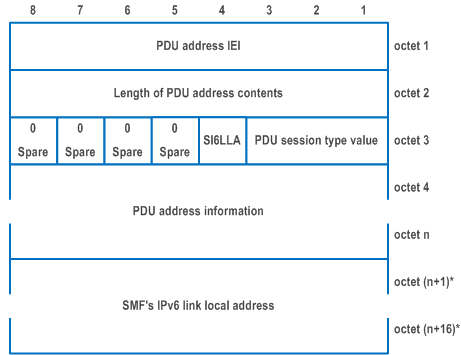
| PDU session type value (octet 3, bits 1 to 3) | |
| Bits
3 2 1 | |
| 0 0 1 | IPv4 |
| 0 1 0 | IPv6 |
| 0 1 1 | IPv4v6 |
| All other values are reserved. | |
| SI6LLA (SMF's IPv6 link local address) bit (octet 3, bit 4) (see NOTE) | |
| 0 | SMF's IPv6 link local address field is absent |
| 1 | SMF's IPv6 link local address field is present |
| Bits 5 to 8 of octet 3 are spare and shall be coded as zero. | |
| PDU address information (octet 4 to n) | |
| If the PDU session type value indicates IPv4, the PDU address information in octet 4 to octet 7 contains an IPv4 address. If the PDU session type value indicates IPv6, the PDU address information in octet 4 to octet 11 contains an interface identifier for the IPv6 link local address. If the PDU session type value indicates IPv4v6, the PDU address information in octet 4 to octet 11 contains an interface identifier for the IPv6 link local address and in octet 12 to octet 15 contains an IPv4 address. | |
| SMF's IPv6 link local address (octet n+1 to n+16) | |
| SMF's IPv6 link local address field contains SMF's IPv6 link local address. | |
|
NOTE:
In the UE to network direction, the SI6LLA bit shall be set to "SMF's IPv6 link local address field is absent".
|
|
9.11.4.11 PDU session type p. 1018
The purpose of the PDU session type information element is to indicate type of the PDU session.
The PDU session type information element is coded as shown in Figure 9.11.4.11.1 and Table 9.11.4.11.1.
The PDU session type is a type 1 information element.

| PDU session type value (octet 1, bit 1 to bit 3) | |
| Bits
3 2 1 | |
| 0 0 1 | IPv4 |
| 0 1 0 | IPv6 |
| 0 1 1 | IPv4v6 |
| 1 0 0 | Unstructured |
| 1 0 1 | Ethernet |
| 1 1 1 | reserved |
| All other values are unused and shall be interpreted as "IPv4v6", if received by the UE or the network. | |
9.11.4.12 QoS flow descriptions p. 1018
The purpose of the QoS flow descriptions information element is to indicate a set of QoS flow descriptions to be used by the UE, where each QoS flow description is a set of parameters as described in subclause 6.2.5.1.1.4.
The QoS flow descriptions information element is a type 6 information element with a minimum length of 6 octets. The maximum length for the information element is 65538 octets.
The QoS flow descriptions information element is coded as shown in Figure 9.11.4.12.1, Figure 9.11.4.12.2, Figure 9.11.4.12.3, Figure 9.11.4.12.4, and Table 9.11.4.12.1.
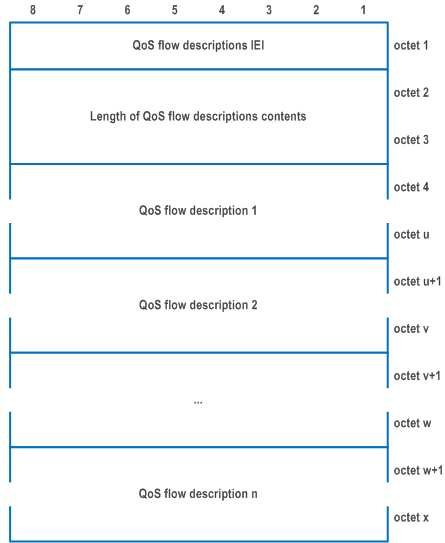
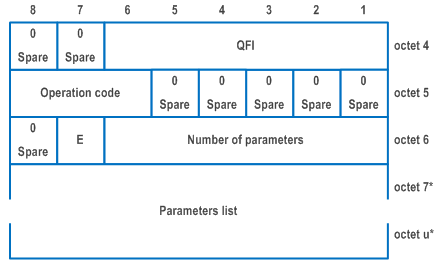
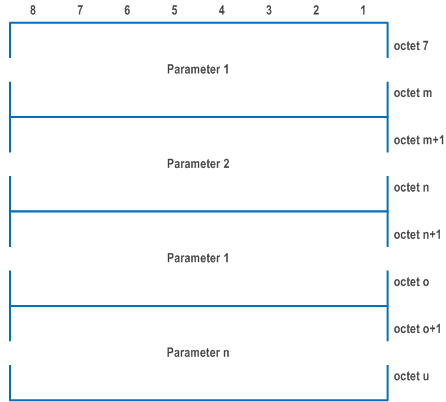
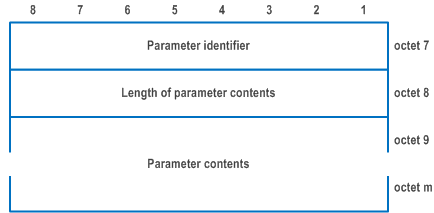
| QoS flow identifier (QFI) (bits 6 to 1 of octet 4) | |
| QFI field contains the QoS flow identifier. | |
| Bits
6 5 4 3 2 1 | |
| 0 0 0 0 0 0 | no QoS flow identifier assigned |
| 0 0 0 0 0 1 | QFI 1 |
| to | |
| 1 1 1 1 1 1 | QFI 63 |
| The network shall not set the QFI value to 0. | |
| Operation code (bits 8 to 6 of octet 5) | |
| Bits
8 7 6 | |
| 0 0 1 | Create new QoS flow description |
| 0 1 0 | Delete existing QoS flow description |
| 0 1 1 | Modify existing QoS flow description |
| All other values are reserved. | |
| E bit (bit 7 of octet 6) | |
| For the "create new QoS flow description" operation, the E bit is encoded as follows: | |
| 0 | reserved |
| 1 | parameters list is included |
| For the "Delete existing QoS flow description" operation, the E bit is encoded as follows: | |
| 0 | parameters list is not included |
| 1 | reserved Bit |
| For the "modify existing QoS flow description" operation, the E bit is encoded as follows: | |
| 0 | extension of previously provided parameters |
| 1 | replacement of all previously provided parameters |
| If the E bit is set to "parameters list is not included", the number of parameters field has zero value. If the E bit is set to "parameters list is included", the number of parameters field has non-zero value. If the E bit is set to "extension of previously provided parameters" or "replacement of all previously provided parameters", the number of parameters field has non-zero value. If the E bit is set to "extension of previously provided parameters" and one of the parameters in the new parameters list already exists in the previously provided parameters, the parameter shall be set to the new value. If the E bit is set to "replacement of all previously provided parameters list" and a parameter in the previously provided parameters is not provided in the new parameters list, the parameter shall be deleted. | |
| Number of parameters (bits 6 to 1 of octet 6) | |
| The number of parameters field contains the binary coding for the number of parameters in the parameters list field. The number of parameters field is encoded in bits 6 through 1 of octet 6 where bit 6 is the most significant and bit 1 is the least significant bit. | |
| Parameters list (octets 7 to u) | |
The parameters list contains a variable number of parameters.
Each parameter included in the parameters list is of variable length and consists of:
| |
| 5QI: | |
| Bits
8 7 6 5 4 3 2 1 | |
| 0 0 0 0 0 0 0 0 | Reserved |
| 0 0 0 0 0 0 0 1 | 5QI 1 |
| 0 0 0 0 0 0 1 0 | 5QI 2 |
| 0 0 0 0 0 0 1 1 | 5QI 3 |
| 0 0 0 0 0 1 0 0 | 5QI 4 |
| 0 0 0 0 0 1 0 1 | 5QI 5 |
| 0 0 0 0 0 1 1 0 | 5QI 6 |
| 0 0 0 0 0 1 1 1 | 5QI 7 |
| 0 0 0 0 1 0 0 0 | 5QI 8 |
| 0 0 0 0 1 0 0 1 | 5QI 9 |
| 0 0 0 0 1 0 1 0 | 5QI 10 |
| 0 0 0 0 1 0 1 1 | |
| to | Spare |
| 0 1 0 0 0 0 0 0 | |
| 0 1 0 0 0 0 0 1 | 5QI 65 |
| 0 1 0 0 0 0 1 0 | 5QI 66 |
| 0 1 0 0 0 0 1 1 | 5QI 67 |
| 0 1 0 0 0 1 0 0 | Spare |
| 0 1 0 0 0 1 0 1 | 5QI 69 |
| 0 1 0 0 0 1 1 0 | 5QI 70 |
| 0 1 0 0 0 1 1 1 | 5QI 71 |
| 0 1 0 0 1 0 0 0 | 5QI 72 |
| 0 1 0 0 1 0 0 1 | 5QI 73 |
| 0 1 0 0 1 0 1 0 | 5QI 74 |
| 0 1 0 0 1 0 1 1 | 5QI 75 |
| 0 1 0 0 1 1 0 0 | 5QI 76 |
| 0 1 0 0 1 1 0 1 | |
| to | Spare |
| 0 1 0 0 1 1 1 0 | |
| 0 1 0 0 1 1 1 1 | 5QI 79 |
| 0 1 0 1 0 0 0 0 | 5QI 80 |
| 0 1 0 1 0 0 0 1 | Spare |
| 0 1 0 1 0 0 1 0 | 5QI 82 |
| 0 1 0 1 0 0 1 1 | 5QI 83 |
| 0 1 0 1 0 1 0 0 | 5QI 84 |
| 0 1 0 1 0 1 0 1 | 5QI 85 |
| 0 1 0 1 0 1 1 0 | 5QI 86 |
| 0 1 0 1 0 1 1 1 | 5QI 87 |
| 0 1 0 1 1 0 0 0 | 5QI 88 |
| 0 1 0 1 1 0 0 1 | 5QI 89 |
| 0 1 0 1 1 0 1 0 | 5QI 90 |
| 0 1 0 1 1 0 1 1 | |
| to | Spare |
| 0 1 1 1 1 1 1 1 | |
| 1 0 0 0 0 0 0 0 | |
| to | Operator-specific 5QIs |
| 1 1 1 1 1 1 1 0 | |
| 1 1 1 1 1 1 1 1 | Reserved |
The network shall consider all other values not explicitly defined in this version of the protocol as unsupported.
If the UE receives a 5QI value (excluding the reserved 5QI values) that it does not understand, the UE shall choose a 5QI value from the set of 5QI values defined in this version of the protocol (see TS 23.501) and associated with:
| |
| Unit of the guaranteed flow bit rate for uplink (octet 1) | |
| Bits
8 7 6 5 4 3 2 1 | |
| 0 0 0 0 0 0 0 0 | value is not used (see NOTE 2) |
| 0 0 0 0 0 0 0 1 | value is incremented in multiples of 1 Kbps |
| 0 0 0 0 0 0 1 0 | value is incremented in multiples of 4 Kbps |
| 0 0 0 0 0 0 1 1 | value is incremented in multiples of 16 Kbps |
| 0 0 0 0 0 1 0 0 | value is incremented in multiples of 64 Kbps |
| 0 0 0 0 0 1 0 1 | value is incremented in multiples of 256 Kbps |
| 0 0 0 0 0 1 1 0 | value is incremented in multiples of 1 Mbps |
| 0 0 0 0 0 1 1 1 | value is incremented in multiples of 4 Mbps |
| 0 0 0 0 1 0 0 0 | value is incremented in multiples of 16 Mbps |
| 0 0 0 0 1 0 0 1 | value is incremented in multiples of 64 Mbps |
| 0 0 0 0 1 0 1 0 | value is incremented in multiples of 256 Mbps |
| 0 0 0 0 1 0 1 1 | value is incremented in multiples of 1 Gbps |
| 0 0 0 0 1 1 0 0 | value is incremented in multiples of 4 Gbps |
| 0 0 0 0 1 1 0 1 | value is incremented in multiples of 16 Gbps |
| 0 0 0 0 1 1 1 0 | value is incremented in multiples of 64 Gbps |
| 0 0 0 0 1 1 1 1 | value is incremented in multiples of 256 Gbps |
| 0 0 0 1 0 0 0 0 | value is incremented in multiples of 1 Tbps |
| 0 0 0 1 0 0 0 1 | value is incremented in multiples of 4 Tbps |
| 0 0 0 1 0 0 1 0 | value is incremented in multiples of 16 Tbps |
| 0 0 0 1 0 0 1 1 | value is incremented in multiples of 64 Tbps |
| 0 0 0 1 0 1 0 0 | value is incremented in multiples of 256 Tbps |
| 0 0 0 1 0 1 0 1 | value is incremented in multiples of 1 Pbps |
| 0 0 0 1 0 1 1 0 | value is incremented in multiples of 4 Pbps |
| 0 0 0 1 0 1 1 1 | value is incremented in multiples of 16 Pbps |
| 0 0 0 1 1 0 0 0 | value is incremented in multiples of 64 Pbps |
| 0 0 0 1 1 0 0 1 | value is incremented in multiples of 256 Pbps |
| Other values shall be interpreted as multiples of 256 Pbps in this version of the protocol. | |
| Value of the guaranteed flow bit rate for uplink (octets 2 and 3) | |
| Octets 2 and 3 represent the binary coded value of the guaranteed flow bit rate for uplink in units defined by the unit of the guaranteed flow bit rate for uplink. When the UE indicates subscribed GFBR for uplink, the "GFBR uplink" parameter is not included in the "Parameters list". When the parameter identifier indicates "GFBR downlink", the parameter contents field contains one octet indicating the unit of the guaranteed flow bit rate for downlink followed by two octets containing the value of the guaranteed flow bit rate for downlink. | |
| Unit of the guaranteed flow bit rate for downlink (octet 1) | |
| The coding is identical to that of the unit of the guaranteed flow bit rate for uplink. | |
| Value of the guaranteed flow bit rate for downlink (octets 2 and 3) | |
| Octets 2 and 3 represent the binary coded value of the guaranteed flow bit rate for downlink in units defined by the unit of the guaranteed flow bit rate for downlink. When the UE indicates subscribed GFBR for downlink, the "GFBR downlink" parameter is not included in the "Parameters list". When the parameter identifier indicates "MFBR uplink", the parameter contents field contains the one octet indicating the unit of the maximum flow bit rate for uplink followed by two octets containing the value of maximum flow bit rate for uplink. | |
| Unit of the maximum flow bit rate for uplink (octet 1) | |
| The coding is identical to that of the unit of the guaranteed flow bit rate for uplink. | |
| Value of the maximum flow bit rate for uplink (octets 2 and 3) | |
| Octets 2 and 3 represent the binary coded value of the maximum flow bit rate for uplink in units defined by the unit of the maximum flow bit rate for uplink. When the UE indicates subscribed MFBR for uplink, the "MFBR uplink" parameter is not included in the "Parameters list". When the parameter identifier indicates "MFBR downlink", the parameter contents field contains one octet indicating the unit of the maximum flow bit rate for downlink followed by two octets containing the value of the maximum flow bit rate for downlink. | |
| Unit of the maximum flow bit rate for downlink (octet 1) | |
| The coding is identical to that of the unit of the guaranteed flow bit rate for uplink. | |
| Value of the maximum flow bit rate for downlink (octets 2 and 3) | |
| Octets 2 and 3 represent the binary coded value of the maximum flow bit rate for downlink in units defined by the unit of the maximum flow bit rate for downlink. When the UE indicates subscribed MFBR for downlink, the "MFBR downlink" parameter is not included in the "Parameters list". In this version of the protocol, for messages specified in the present document, the sending entity shall not request 0 kbps for both the maximum flow bit rate for downlink and the maximum flow bit rate for uplink at the same time. Any entity receiving a request for 0 kbps in both the maximum flow bit rate for downlink and the maximum flow bit rate for uplink shall consider that as a syntactical error (see clause 7). When the parameter identifier indicates "averaging window", the parameter contents field contains the binary representation of the averaging window for both uplink and downlink in milliseconds and the parameter contents field is two octets in length. When the parameter identifier indicates EPS bearer identity, the length of EPS bearer identity is one octet, bits 5 to 8 of the parameter contents contain the EPS bearer identity as specified in subclause 9.3.2 of TS 24.301 and bits 1 to 4 of the parameter contents are spare and shall be coded as zero. The UE shall not include the EPS bearer identity parameter in any mobile originated 5GSM messages (see NOTE 1). | |
|
NOTE 1:
The total number of EPS bearer identities included in all QoS flow descriptions of a UE cannot exceed fifteen.
NOTE 2:
In this release of the specifications if received it shall be interpreted as value is incremented in multiples of 1 Kbps. In earlier releases of specifications, the interpretation of this value is up to implementation.
|
|